Lower East Coast NZ
It’s Monday, March 23rd. With Christchurch’s density and the coastal plain behind us, we found our way to Oamaru down Route one, still on the coast. Oamaru is an old city in New Zealand having been established in the early 1800’s. The city fathers must have had a vision of its future because they made the streets very wide, so wide even now with automobiles and truck traffic they are more then sufficient. The buildings are grander then in any other city we have seen here on the island. They are formed of large blocks of native limestone which came from the quarry where the penguin colony lives that we will visit tonight.. Since we were looking for lodging near the colony, we got a room at the King’s Gate Brydone Hotel, a very old hotel which had formally been the “Queen’s Hotel” since the late 1800’s. It is very nicely kept but still an old hotel. The rooms are small, obviously built without “facilities” which were then added in later when such amenities became popular. There is a formal dining room downstairs where one can imagine great doings having taken place in this town’s history. Our room is on the “first floor” (second floor in American-speak, with what we call the first floor being “ground floor” here) but our window looks out over the parking area where the bike is moored for the night . We can see the coast line from here and I can picture the visitors from a bygone time looking out these windows at the masts of sailing ships coming and going along the wharf. We went for a walk down through the old commercial buildings which once were warehouses and processing points for the various cargos but now are restaurants, pubs and specialty shops. Still, it doesn’t have a slick tourist-fleecing feel, but more like a town center with hubs where people gather. There are as many locals as tourists. One of the locals strikes up a conversation with us in the pub where we’re eating our fish & chips. Turns out, as is so often the case here, he’s a rider too and wants to talk about his bike, a Guzzi (they do seem to be popular here !) and his travels.
We have just come back from watching the blue penguin colony return to the nesting area from their day at sea at Oamaru. There is a viewing area set up at the end of a gravel road, in the abandoned quarry where penguins have been coming for perhaps two million years, interrupted only briefly by human activity. The area is lit at night with an orange wavelength light that the penguins cannot perceive, so that we can see them but they are in the “dark”. There are no photographs permitted, to avoid the possibility of unwanted flashes that will upset the return migration. The birds start to arrive back at the colony a short time after nightfall, about 8pm this time of year, and make their laborious way up the rocky bank. They stop periodically to spread their flippers and shed body heat that they’ve built up in their day (or days…or sometimes weeks) of swimming. They are tiny things, no more than about 18 inches high, I’d guess, but they can swim as much as 75 kilometers (about 46 miles) in a day’s feeding session. But from far out their in the ocean, their instinct leads them back to this small bank of rocks. Eventually they reach the level area that is to us a narrow gravel road, but to them a “no man’s land” they must cross to reach the protected nest boxes set up in a field of grassy hummocks. They stop at the edge of the road, look both ways several times, then in a group waddle quickly across, getting up surprising speed for such an awkward gait on land. Once in the nesting area, they split up like commandos taking up positions in hostile territory, making their way to the boxes. Then, after about a half hour or so, you can see some of them emerging from boxes, waddling across the grass and ducking into another box. Blue Penguins do mate for life, but one can almost picture in this scenario Mr. Penguin telling Mrs. Penguin he has to pop out for a pack of haddock and he’ll be back in about an hour (Or maybe it’s the other way around…I’m not real sure I can tell one gender from another, but I’ll bet they can, even in the dark.)
After most of tonight’s crew had arrived (one can never be sure how many will arrive on any given night, since when there are no chicks, the adults can stay out at sea for long periods) there is a quiet period and then begins a strange trilling back and forth from one box to another, which is either reporting in for the night, a beacon to help guide in the stragglers or the Penguin version of “Good night John-Boy”. Whatever it is, it’s eery. Brenda, who has better ears than I do, says she could hear “clicks” from the ones coming ashore that seemed to respond to the trilling from the nest boxes, apparently like a homing call or encouragement to help the group get back together on shore.
It is March 24th Tuesday. We left Oamaru at about 10:00 am after a nice breakfast at The Bridge Café. I tried “lolly cake” as an addition to my cereal breakfast. It is a signature dessert here in New Zealand composed of a dense, sweet moist cake containing slices of meringue like candy which comes in the form of “Eskimos” which the cook inserts in the batter. When sliced the candies make a colorful set of splotches in the cake. It’s quite tasty, but I really don’t need to start liking yet another sweet goody down here. I’ve already let out the velcro straps on my jacket as far as they’ll go.
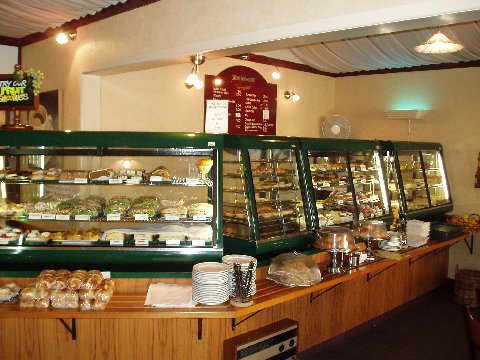
(Just another typical NZ cafe with good things to eat....the reason why my riding clothes are shrinking fast)
On the road we headed south on Route 1 for the Moreraki boulders only a few miles, maybe 20 or so, south. These are a natural phenomenon, which look like enormous bowling balls on the beach. They are perfectly spherical and some are much as six or more feet in diameter. The rock flow on the beach looks like lava rock and I came up with a theory in my head about igneous flow and surface tension forming this shape, but I was, of course, completely wrong. Apparently these Moreraki boulders are not igneous in nature but are ,according to the information brochure we picked up , concretions formed something like pearls when a particular kind of mineral begins to attract other minerals to form around it in layers which eventually build up to these huge round boulders. They form on the sea floor when conditions are right and then in this case, when the sea floor is raised by tectonic collisions (which also formed these lovely mountains) the boulders are in the resulting seaside cliffs, waiting to be exposed by erosion, then rolling down the cliff to congregate on the beach as if someone very large had left a pool game in progress.
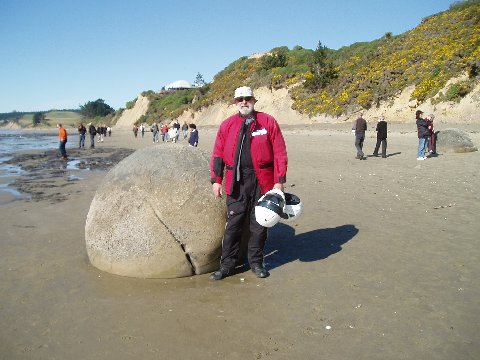
(I'm just another large round object on the beach)
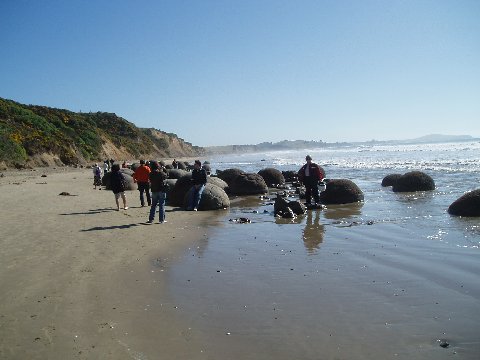
(Brenda and others waiting for the "Great Rack of Moreaki" to descend and start the billiard game anew)
After leaving there we stopped in at the town of Moreraki Point which, despite its very small size (probably less then a 1,000 people) has an internationally known restaurant called Fleur’s. This restaurant is in an old fish house sitting out on a point jutting into the Pacific and Moreraki Bay. We went there for lunch and sat out on the balcony overlooking the ocean. Our meal was fantastic. I had groper, a local fish not be confused with our grouper, and Brenda had seafood chowder with two kinds of homemade bread. I also had a chocolate torte for dessert simply because I didn’t want the meal to end. Brenda had a glass of wine but since I was riding the bike I did not partake. We sat there quite awhile in the warm sun looking out over the Pacific in this beautiful spot and decided that we really didn’t need to be going anywhere all that quickly.
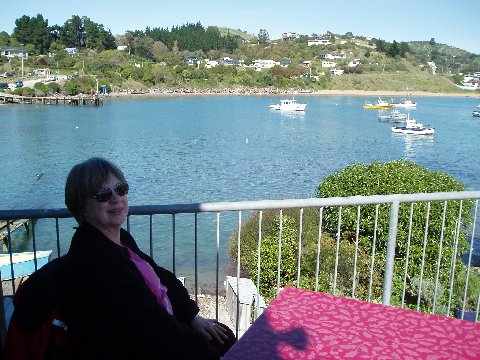
(On the balcony at Fleur's)
We left Fleur’s and went down the road and found the Moreraki Motel with a vacancy. This is not a motel in a conventional sense but instead a collection of small buildings which have been converted into rooms for rent for a day or longer. What we ended up with was a small “holiday cabin” or closer to what they would call a “Bach” here. It is a small cabin with a kitchen, living room area and two small bedrooms. It looks like it has been constructed piecemeal with no particular planning. However it has two large windows in the front which look out over the Pacific, a view that one would pay a small fortune to have in the states. Here the price for this is $95 NZ, about $56 US at that day’s exchange rate.
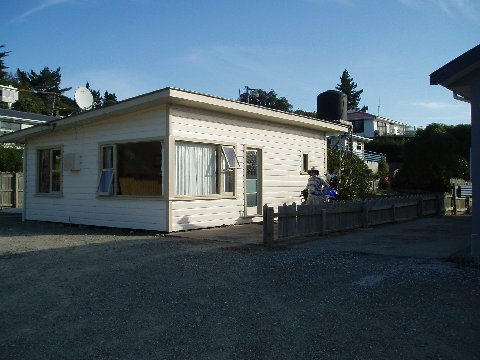
(What you get for $56 in NZ. With little effort, Brenda could have thrown a rock in the Pacific from there....had she been so inclined)
With lodging secured we took off an exploration walk. We went down the heritage trail, a path that has been made alongside the ocean leading back toward the Moreraki boulders. The beach here is mainly rocks rather than sand (come back in five million years or so and it will be sand, so I guess it’s a “starter beach”). The path climbs up and down the cliffs, in and out of secluded tree-lined tunnel-like walks, but from most of it you can still see the bay. Brenda thinks that she saw a penguin diving for fish and coming up to breathe. Again, we were the only people out there that day. And, as is the usual situation here in NZ, no litter marred the trail.
Later that evening we walked back to Fleur’s for supper. The rather rustic old building was packed for the evening meal but we had made reservations for our same balcony area. We sat out there while the sun went down over the mountains behind the beach and the air grew colder. Even though it finally got down to probably in the 50’s we were determined to stay outside as long as possible. Brenda had the scallops and I had white fish fillets with whitestone rarebit and the carrot soup. It was all excellent. We managed to finish off a bottle of wine, since we were walking back to our lodging rather than riding the bike.
While having dessert inside (we finally couldn’t take the cold any longer) we ended up in conversation with Fleur herself who informed us that her friend had just gone to Kentucky to learn more about Bluegrass music. We got her to autograph one of her cookbooks for our daughter in-law Rhonda and she took my pen to remember us by.
We walked back to our lodging by moonlight along the narrow winding road that skirts the edge of the bay. A person could get to like this sort of thing, if he worked at it.